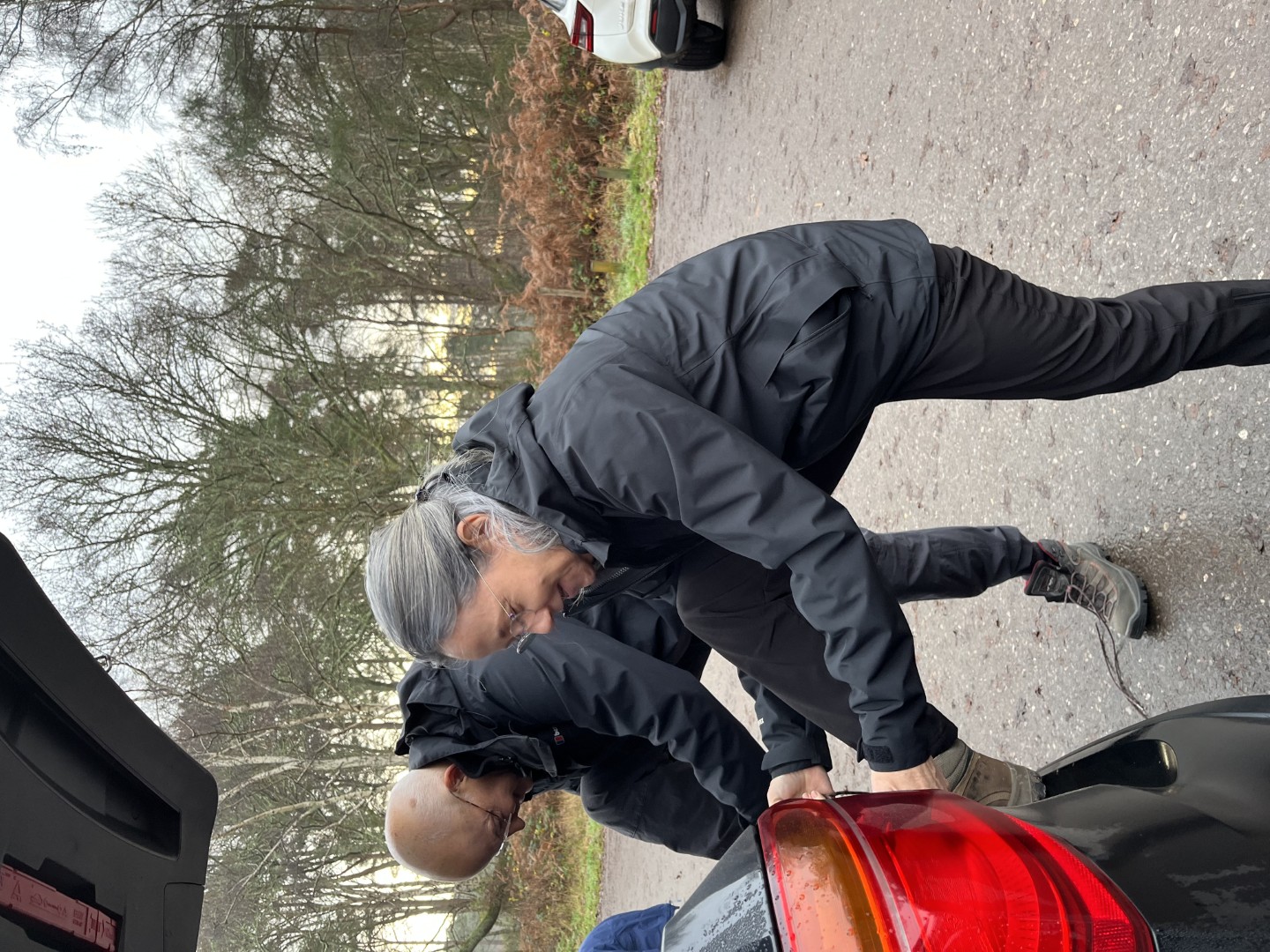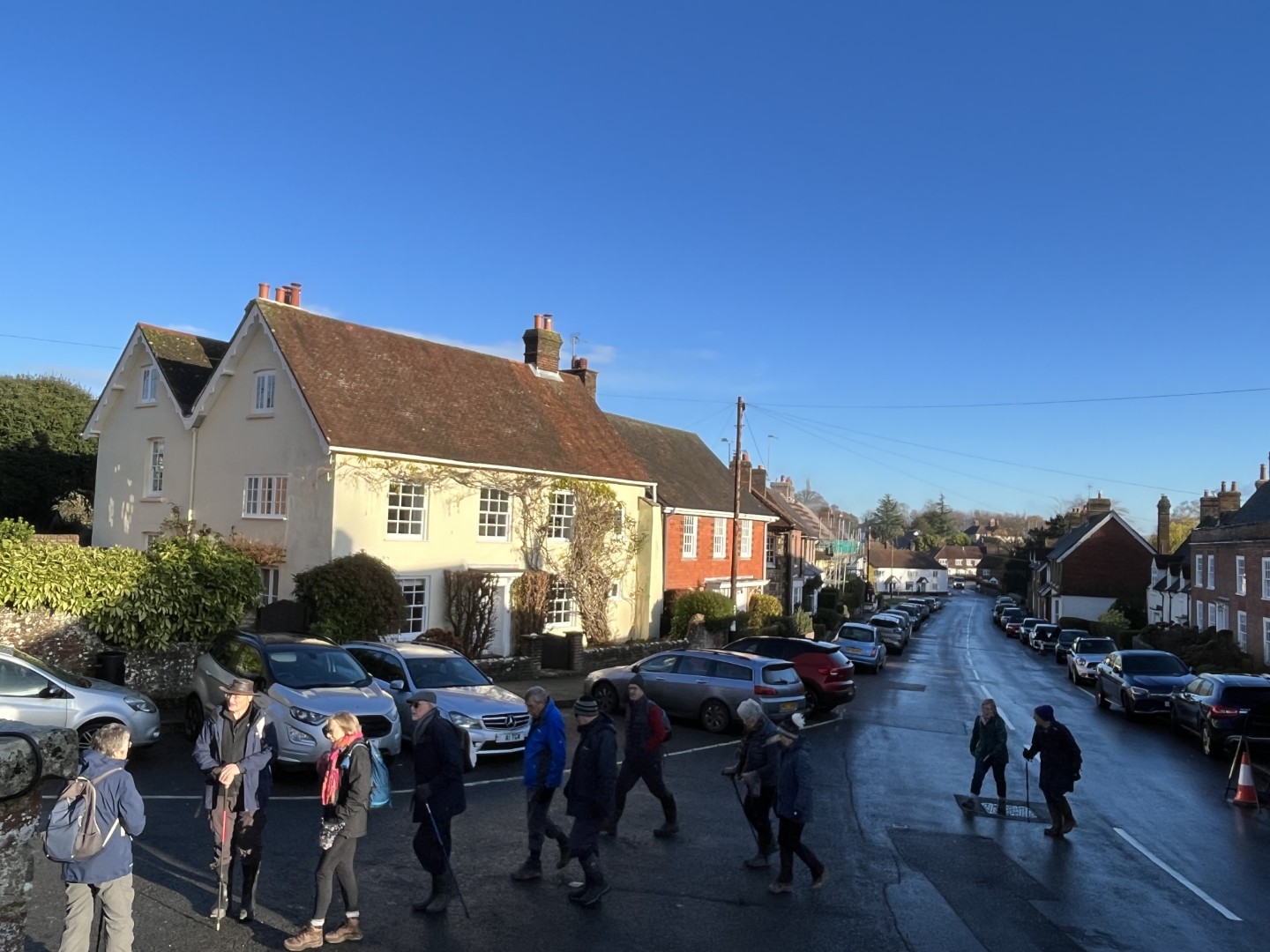Gallery (Click on titles!)
-
Stedham walk on 17th December 2025

Our last walk before Christmas had a good turn out at the car park on Stedham Common. We took the Serpent Trail across the heath of Stedham Common over Minsted Road towards Woolmer Bridge. At the bridge we stayed on the Serpent Trail over the Severals, crossing the Petersfield Road onto the Woolbeding road and over the stone multi span 16th Century bridge. The footpath on the National Trust land took us across the field but we needed to take a detour up the hill to avoid the footbridge under repair. At the top we stopped for our coffee break before coming back down the hill to Stedham Mill. From there we followed the bank of the River Rother to Iping where we walked up Iping Lane onto Elsted Road back to the car park. We retired to Fratelli’s for our Italian lunch.
West Dean and Trundle Christmas Party walks

With our Christmas party being in the Selsey Arms in West Dean it seemed a good place from which to start our walks. The more energetic members chose to conquer the Trundle, the large hill that overlooks Goodwood horseracing course. The other members chose a flatter walk along the tracks towards Lavant.
We all set off together and parted ways along the Monarch's Way, next to the West Dean park wall. The Monarch's Way is roughly based on King Charles escape route to Europe but why he wanted to ascend The Trundle is anyones guess. We reached the lower slopes and were much tempted to have a drinks stop, but bravely voted to top the Trundle first. At the top the views were fairly good but there were a number of dark clouds heading our way and there was also a strong wind. A quick circuit of the site of the Iron age hill fort and we retreated to a sheltered corner further down to have our refreshments. We turned down onto The New Lipchis Way for a gentle descent and as we reached the bottom of the valley, we turned north and headed for the pub.
Meanwhile the shorter walkers had taken the valley route towards Lavant and then turned back along the route of the Midhurst to Chichester railway that closed to passengers in 1935. Some of the walkers were a bit nervous about ghost trains still running. Can't think why........What's that? Part of the line was used for goods up until 1991. A nice walk, perhaps because they had no hill to climb, but it also meant they got back to the pub a lot earlier! We had a spendid Christmas lunch and were joined by several of our social members, which made it even more special. Pauline had organised a Secret Santa so we had a difficult time trying to chose a mystery present after our lunch, so we all left the premises fairly full, a little tired and clutching a Christmas gift!
South Harting walk on 3rd December 2025

The 4.3 mile walk around South Harting promised to be a bit squelchy underfoot because of the torrential rain over the previous few days. We congregated near The White Hart in South Harting, welcoming a new walker, John before wandering up to the start point at St Mary and St Gabriel’s church. The stocks outside the church were sampled, before walking around the back of South Harting to cross the road to Petersfield, over the field onto West Harting Road. Taking the east footpath on the village outskirts we stopped a couple of times to watch the deer in the farm towards Upperton on muddy paths through woodland. Crossing Bohemia Hollow, we followed the path across a stream where a suitable tree trunk served as a seat for our coffee break. Stirring ourselves, up the hill and into East Harting we left the road onto the west path by Hollist Farm, turning south to skirt the water treatment works where we managed to persuade someone to take a team photo. A right turn over a field reminded us that we should have come with our Regency outfits on to pose in front of an idyllic period house. More field walking brought us to Mill Lane and back to South Harting to enjoy a long lunch at The White Stag.
Winchester walk on 26th november 2025

After parking in St Catherine's car park, Tim and Jane's walk headed away from the city. After a short stroll we reached the bottom of St Catherine's Hill, which is a bit challenging and walkers who didn't feel the need of a challenge were able to buy a coffee and use a shortcut to catch up a bit later. The Hill is 318ft above sea level and has some great views. We had a look at the mizmaze but as it is nearly 1/2 mile to walk it, we decided to not accept the challenge. After a wander around we descended using newly built steps - which had antislip inserts in them, much needed where the frost was still evident. At the bottom we took a diversion to find the site of a medieval burial site, one of several in the Plague Pits Valley. When the Black death ocurred in 1348/1349 and a subsequently in 1361/1362, the city ran out of burial sites. Digging pits for mass burial was the only option and this valley next to St Catherine's Hill was chosen. Statistics vary but it is likely that half of England's population perished in that period.
We then walked along the edge of the River Itchen flood plain turning north where a road has been constructed. Another turn along a footpath brought us to the Hospital of St Cross where we stopped for a coffee. We also went inside the building and had a very informative chat with the lady looking after the Porters Lodge gift shop. She kindly offered us a small beer and a piece of bread, a custom dating back to the 12th Century and it would have been rude to refuse. Although free to any passing wanderer, we did actually make a small donation. This almshouse is the oldest continuous charity in the country and looks after 25 widowers or single men, normally of limited means. Guided tours are available and our host especially recommended a trip to the top of the tower. Click here:- St Cross Hospital.
Continuing alongside the River Itchen we eventually reached the city, passing the last residence of Jane Austen on the way. There was a large German Market in the Cathedral Grounds which we wandered through on our way to The Giggling Squid, to have an enjoyable lunch and to meet up with holiday makers recently back from Portugal. We then wandered back to the Guildhall area where we were able to catch our free bus back to the car park.
Stedham walk on 19th November 2025

Arriving at Iping Common car park we huddled in our cars hoping that either the snow would stop or Isabel was going to change the walk to many, many circuits of the bar at the Hamilton Arms before lunch. However, after girding our loins, finding our umbrellas and dressing appropriately, we embarked on our walk. In the event the snow stopped in less than half an hour, so we had made the right decision, although it was replaced later by some rain. After taking the Serpent Trail over Stedham Common, we headed for Woolmer Bridge but then headed south for Quags Corner near Minsted - not to be confused with the Quags Corner near Horsham. Quag is an archaic term for a marsh or bog, but in spite of the earlier snow we found it reasonably easy walking. We then followed the fence shielding us from the extensive sandpit on Mitchells Common and eventually emerged at Fitzhill where we could see snow had settled on Harting Down. A field with a few horses in it showed no sign of snow but the horses looked cold and damp and disappointed we had no food for them! After crossing the Elsted road we soon found a suitable stopping point for a drinks break. Suitably refreshed, we skirted the edge of Trotton Common before eventually turning east and then reaching Iping Common and our parked cars. In spite of the weather we found the walk very rewarding. After a short drive to The Halmilton Arms anyone suffering from the cold weather soon warmed up and we all had some delicious Thai food from the extensive menu.
Recent galleries
- Stedham walk on 17th December 2025
- West Dean and Trundle Christmas Party walks
- South Harting walk on 3rd December 2025
- Winchester walk on 26th november 2025
- Stedham walk on 19th November 2025
History
2025
- December (3)
- November (4)
- October (5)
- September (4)
- August (4)
- July (5)
- June (4)
- May (5)
- April (4)
- March (5)
- February (3)
- January (4)
2024
- December (3)
- November (5)
- October (4)
- September (4)
- August (4)
- July (4)
- June (5)
- May (5)
- April (5)
- March (5)
- February (5)
- January (4)
2023
- December (3)
- November (6)
- October (5)
- September (5)
- August (3)
- July (4)
- June (6)
- May (5)
- April (4)
- March (5)
- February (4)
- January (4)
2022
- December (4)
- November (5)
- October (5)
- September (3)
- August (4)
- July (6)
- June (11)
- May (4)
- April (5)
- March (4)
- February (5)
- January (4)
2021
2020
- December (4)
- November (1)
- October (5)
- September (4)
- August (3)
- July (3)
- March (2)
- February (5)
- January (3)
2019
- December (2)
- November (5)
- October (4)
- September (3)
- August (4)
- July (4)
- June (11)
- May (5)
- April (4)
- March (3)
- February (5)
- January (5)
2018
- December (2)
- November (4)
- October (4)
- September (5)
- August (4)
- July (3)
- June (5)
- May (8)
- April (4)
- March (4)
- February (5)
- January (3)
2017
- December (3)
- November (5)
- October (3)
- September (4)
- August (4)
- July (4)
- June (11)
- May (4)
- April (4)
- March (3)
- February (4)
- January (5)
2016
- December (3)
- November (4)
- October (5)
- September (4)
- August (3)
- July (6)
- June (11)
- May (4)
- April (5)
- March (3)
- February (10)
- January (2)
2015
2014
- June (2)
1997
- February (1)